FORT EUSTIS, Va. ― Pilot testing is underway for the new Army Combat Fitness Test. If you aren’t in one of 63 battalions who are getting an official introduction via mobile training teams, there are still some things you can do to prepare yourself for next fall, when the entire Army joins in on the pilot.
The new test has six events, a few of which probably look familiar. One involves a pull-up bar, another is a modified push-up and that 2-mile run is still alive and well.
There are a few modifications to some of the events that soldiers can choose to use, and some other tips to make sure that your reps count for the grade.
Speaking of grading, during this year-long pilot, the Center for Initial Military Training will be gathering soldier statistics to figure out whether the current scoring standards are ideal. In all likelihood, though, it will be harder to max than previously.
“We need to look at that ‘band of excellence,’ where we kind of want soldiers to land, but we need them there in every event,” Whitfield East, a CIMT research physiologist, told Army Times. “So what we’ve seen so far is we have individuals who do very well at aerobic events and very well at strength and power events ― we need soldiers to do well in all events.”
Scoring perfect 100s is going to be a lot harder, he said.
“You go through this, the first iteration, and you start to realize that 80-80-80 is a really good score," he said.
Keep these tips in mind:
The deadlift
Right off the bat, the team at CIMT went with a hexagon-shaped deadlift bar, which you raise with your hands parallel to your sides, rather than the single, straight-across Olympic bar.
“You pretty much just sit down in it, and then lift up,” CIMT Command Sgt. Maj. Edward Mitchell said during a demonstration Tuesday with advanced individual training drill sergeants and other cadre from the 128th Aviation Brigade.
Currently, the minimum weight is 140 pounds, and the max is 340. In training for the test, soldiers should have a good idea of what their ideal weight is, and multiple bars will be set up with incrementally greater weights.
You have to do three continuous reps for a grade, but you can take a practice rep to make sure the weight is right. If it isn’t, soldiers can move up or down in weight if they feel their first rep was too heavy or too light.
It’s important to keep a straight back during the event, and to stand up in one fluid movement. If a soldier straightens his or her legs first, then brings their upper body upright, the rep doesn’t count.
Standing power throw
To approximate the kind of power a soldier might need to lift a casualty over a shoulder or leap over a ditch, the ACFT requires participants to toss a 10-pound medicine ball backwards, over their heads.
You can wind up for it by bending the knees and swinging the arms a few times. And yes, you can also get some air, as long as your feet land in front of the line on the ground.
“It’s okay to jump, because it shows they can generate that power,” East said.
You get two “faults” if you accidentally cross the line following the throw. After that, you fail the event.
For now, the ball needs to travel at least 4.6 meters, but 13.5 is the 100-point max. While most soldiers on Tuesday were hitting in the 8- or 9-meter mark, East said he’d seen soldiers throw as far as 15 meters.
Hand release push-ups
The Army is still mulling whether to go with a push-up that requires a soldier to lift up their hands after lowering to the ground, or one that requires you to put your arms out to the side after lowering.
In any case, the idea is that each push-up will require lowering the body flat on the ground and then lifting up again, without bouncing or using any momentum to get back up.
“It reduces the wear and tear on shoulders,” East said, by forcing a soldier to do fewer reps while requiring more muscular endurance to come up from the ground.
There are a couple of extra specifications about these types of push-ups for the ACFT, though. Particularly important is the rest position.
Unlike the current APFT push-ups, soldiers must keep a straight back while resting in between reps. Letting your butt drop or “piking” your hips so your body is in a triangle pose is not allowed.
RELATED

Spring, drag, carry
This compound event consists of a 50-meter course that requires soldiers to sprint, drag a 90-pound sled, shuffle laterally down the field, carry two 40-pound kettle bells and then sprint up and down again.
“This is 250 meters of maximum effort, so they go anaerobic really fast,” East said.
For the sled drag, soldiers can pick the grip that’s most comfortable for them. That means they can hold onto the looped handles at the edge of the strap, put their hands through the loops for a better grip, or ignore the handles all together and hold the straps below them.
And though this event is designed to pretty much exhaust you, you have to maintain some control throughout. Officials stressed that at the end of the kettle bell carry, you must set the weights down gently rather than toss them to the ground at the end.
Leg tuck
It happens on a pull-up bar, but it’s definitely not a pull-up. Soldiers position their bodies parallel to the bar, with one hand in front of the other.
Trainers said that most people will put their dominant hand closest to the face, with the other hand behind.
There are also two options to complete the event: Either you lift your legs up so that your knees meet your elbows, or if it’s more comfortable, you can roll your knees up to your shoulders.
A pro tip from CSM Mitchell: Lean back as you tuck so your body is parallel to the ground when you complete a rep. That way it’s easier to get your knees all the way up.
The run
Nothing’s really changed here, but the test is designed so that you will be pretty physically exhausted before it starts. Make sure to drink some water, stretch and catch your breath during the five-minute break.
Meghann Myers is the Pentagon bureau chief at Military Times. She covers operations, policy, personnel, leadership and other issues affecting service members.





